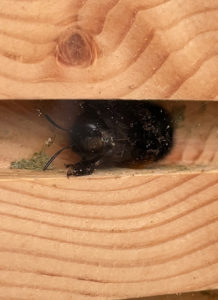Hairy-footed flower bees love lungwort!
At first glance, the all-black female can easily be mistaken for a queen bumblebee in the early spring, albeit she is somewhat smaller and lacks the usual yellow or white bands of some bumblebee queens that forage around the same time of year and even on some of the same plants. A preferred flower they use is lungwort, a useful source of early nectar for some bees, especially the younger red flowers which change to blue as they age. Plant this and you are more likely to attract them if they are in your area.
Lungwort (Pulmonaria officianalis) flowers are well known as hairy-footed flower bee magnets. Being bell-shaped flowers, only long-tongued bees can access the nectar and this bee has a visibly long tongue. On many occasions, I noticed they flew around without retracting it under their bodies. I watched several of these females, hovering around the flowers, with their high pitched buzzing sounds, which are much higher than the queen bumblebee buzz and distinctive quick darting flight, all foraging in the Port Sunlight garden centre. There were males as well, which are so distinctly different from the black-haired females with golden brown body hairs, fair ‘moustaches’ similar to Red Mason bee males and long bristle-like hairs, on their middle legs, hence their name. They too dart from flower to flower or female to female! Stone in his study of female harassment by males, states that they will also use comfrey (Symphytum orientale) which males patrolled in their mating quest. Comfrey is a plant I have used over the years as an organic tomato liquid feed. Although it can smell!
Although resembling bumblebees, they are in fact solitary bees, that can will live in larger communities if conditions are right for them and remain solitary even in larger nest site communities. I have never myself found a nest site, even though they are common in the UK and I have not seen any such bees in any of my gardens.
To get into my garden, a plant has to ‘earn its place’ and provide something for wildlife. Then I will provide it with a new home! I bought a couple of the Victoria Brooch species of pulmonaria that the bees were using at the garden centre and they have a new home! Now I need to keep an eye out for these lovely solitary bees!
Where can they be found?
Parks, gardens, garden centres, quarries, churchyards, soft rock cliffs, woodlands and preferring areas of bare compacted clay soils.
Where do they nest?
As you can see I do know they will use a nurturing nature nest box to rest inside, but I doubt they will ever nest in one!

They prefer to nest in a soft mortar and exposed cob of older walls, and they will nest gregariously.
Making a cob brick bee hotel by John Walters
Cob brick bee hotels are a useful addition to a bee garden and can be used to attract species such as the Hairy-footed Flower Bee (Anthophora plumipes), a common garden bee in England that usually nests in vertical earth banks, cob walls and mortar joints in old crumbling masonry. It is one of the earliest species to fly each year and is a welcome sign of spring. The main flight period is between March and May.
Each brick takes just a few minutes to make. For a standard (21 x 9 x 6 cm brick) 2.5 kg of clay-rich soil is placed in a bucket with some straw, barley straw is recommended over wheat straw but any dried grasses can be used. Mixing is similar to making pastry. Water is added a little at a time until the mixture is malleable but not too wet. It is then pressed into a brick shape or mould. Holes about 10 mm across are added whilst the cob is still damp. Then add a variety of hole sizes from 3 mm to 12 mm. The brick is then left to dry slowly, it can be placed in the sun but must be covered to protect it from rain. It will take two to four weeks to dry depending on the weather conditions and is then ready for use. The brick should be placed out of the rain preferably in a south-facing situation 1 – 3 metres from ground level.
See hairy-footed flower bees using John’s homemade bee cob bricks
Cob brick bee hotels are available commercially eg Cobbee bricks from www.earthblocks.co.uk.
Download the hairy-footed flower bee leaflet by BWARS
Some excellent photographs here by Steven Falk
Many thanks to John Walters for his films and to Emily Doorish for the photo of the hairy-footed flower bee female, resting inside a Nurturing Nature nest box




Recent Comments